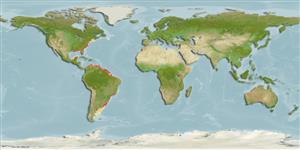>
Eupercaria/misc (Various families in series Eupercaria) >
Sciaenidae (Drums or croakers)
Etymology: Paralonchurus: Greek, para = the side of + Greek, logchos = lance + Greek, oura = tail (Ref. 45335).
More on author: Steindachner.
Environment: milieu / climate zone / depth range / distribution range
Écologie
marin; saumâtre démersal; profondeur ? - 50 m (Ref. 9626). Tropical
Western Atlantic: Panama to southern Brazil. Reported in Yucatan, Mexico (Ref. 74908).
Length at first maturity / Taille / Poids / Âge
Maturity: Lm 15.7 range ? - ? cm
Max length : 33.7 cm TL mâle / non sexé; (Ref. 125970); common length : 25.0 cm TL mâle / non sexé; (Ref. 3702); poids max. publié: 520.00 g (Ref. 125970)
Épines dorsales (Total) : 11 - 12; Rayons mous dorsaux (Total) : 29 - 30; Épines anales: 2; Rayons mous anaux: 8. Body silvery to yellowish, brown above, whitish below. Sides with 7 to 9 dark vertical bars extending to below lateral line. A large dark brown spot, larger than eye, behind upper end of gill slit. Mouth small, inferior, nearly horizontal. Chin with 5 pores and many barbels, 3 or 4 pairs in a tuft around median pore and 10 to 12 pairs along inner edges of lower jaw. Caudal fin asymmetrically rhomboidal with lower half pointed. Gas bladder well developed, much longer than head length, bearing anteriorly 2 pairs of appendages, anterior pair slit and horn-like, lateral pair long, tube-like, and extending posteriorly to tip of main chamber (Ref 51721).
Found over muddy bottoms, often near estuarine areas (Ref. 9626). Feeds mainly on worms (Ref. 3702). Marketed mostly fresh and salted (Ref. 3702).
Life cycle and mating behavior
Maturité | Reproduction | Frai | Œufs | Fécondité | Larves
Cervigón, F., 1993. Los peces marinos de Venezuela. Volume 2. Fundación Científica Los Roques, Caracas,Venezuela. 497 p. (Ref. 9626)
Statut dans la liste rouge de l'IUCN (Ref. 130435: Version 2024-2)
Menace pour l'homme
Harmless
Utilisations par l'homme
Pêcheries: intérêt commercial mineur
Outils
Articles particuliers
Télécharger en XML
Sources Internet
Estimates based on models
Preferred temperature (Ref.
123201): 14 - 27.8, mean 24 °C (based on 564 cells).
Phylogenetic diversity index (Ref.
82804): PD
50 = 0.5156 [Uniqueness, from 0.5 = low to 2.0 = high].
Bayesian length-weight: a=0.00759 (0.00705 - 0.00816), b=3.08 (3.06 - 3.10), in cm total length, based on LWR estimates for this species (Ref.
93245).
Niveau trophique (Ref.
69278): 3.4 ±0.3 se; based on diet studies.
Résilience (Ref.
120179): Haut, temps minimum de doublement de population inférieur à 15 mois (Preliminary K or Fecundity.).
Fishing Vulnerability (Ref.
59153): Low vulnerability (24 of 100).
Nutrients (Ref.
124155): Calcium = 184 [108, 359] mg/100g; Iron = 1.18 [0.63, 2.04] mg/100g; Protein = 19 [18, 20] %; Omega3 = 0.243 [0.129, 0.403] g/100g; Selenium = 48.1 [26.7, 89.8] μg/100g; VitaminA = 20 [8, 53] μg/100g; Zinc = 1.49 [1.09, 2.12] mg/100g (wet weight);
